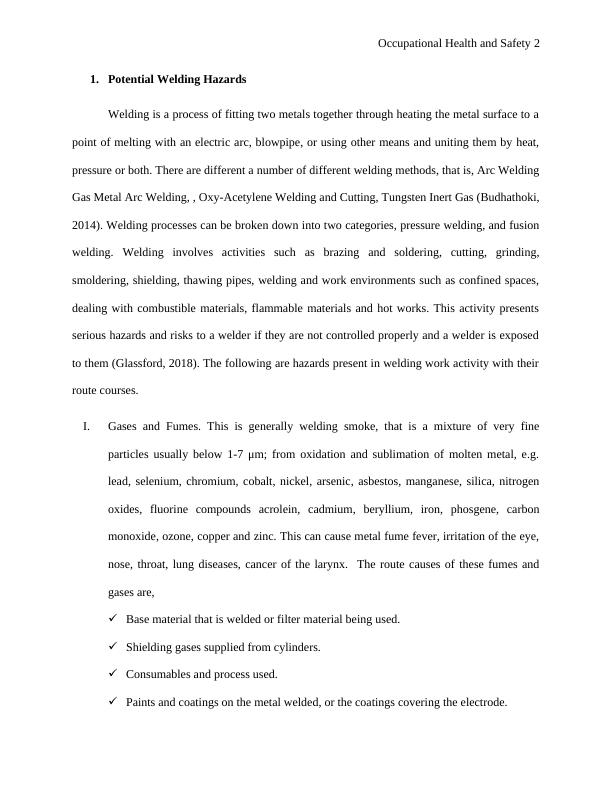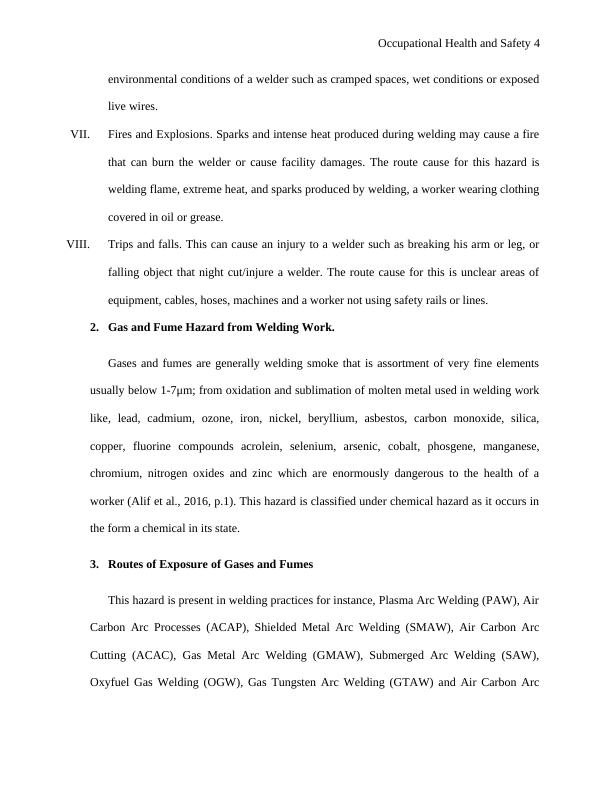Potential Welding Hazards and Gas/Fume Hazard from Welding Work
13 Pages3583 Words498 Views
Added on 2023-06-13
About This Document
This article discusses the potential hazards of welding work, including gases and fumes, and their routes of exposure. It also covers the health effects of exposure, monitoring and analyzing methods, and legislative codes and standards that must be followed to ensure worker safety.
Potential Welding Hazards and Gas/Fume Hazard from Welding Work
Added on 2023-06-13
ShareRelated Documents
Occupational Health and Safety 1
Occupational Health and Safety
By Student’s Name
Course + Code
Class
Institution
Date
Occupational Health and Safety
By Student’s Name
Course + Code
Class
Institution
Date

Occupational Health and Safety 2
1. Potential Welding Hazards
Welding is a process of fitting two metals together through heating the metal surface to a
point of melting with an electric arc, blowpipe, or using other means and uniting them by heat,
pressure or both. There are different a number of different welding methods, that is, Arc Welding
Gas Metal Arc Welding, , Oxy-Acetylene Welding and Cutting, Tungsten Inert Gas (Budhathoki,
2014). Welding processes can be broken down into two categories, pressure welding, and fusion
welding. Welding involves activities such as brazing and soldering, cutting, grinding,
smoldering, shielding, thawing pipes, welding and work environments such as confined spaces,
dealing with combustible materials, flammable materials and hot works. This activity presents
serious hazards and risks to a welder if they are not controlled properly and a welder is exposed
to them (Glassford, 2018). The following are hazards present in welding work activity with their
route courses.
I. Gases and Fumes. This is generally welding smoke, that is a mixture of very fine
particles usually below 1-7 μm; from oxidation and sublimation of molten metal, e.g.
lead, selenium, chromium, cobalt, nickel, arsenic, asbestos, manganese, silica, nitrogen
oxides, fluorine compounds acrolein, cadmium, beryllium, iron, phosgene, carbon
monoxide, ozone, copper and zinc. This can cause metal fume fever, irritation of the eye,
nose, throat, lung diseases, cancer of the larynx. The route causes of these fumes and
gases are,
Base material that is welded or filter material being used.
Shielding gases supplied from cylinders.
Consumables and process used.
Paints and coatings on the metal welded, or the coatings covering the electrode.
1. Potential Welding Hazards
Welding is a process of fitting two metals together through heating the metal surface to a
point of melting with an electric arc, blowpipe, or using other means and uniting them by heat,
pressure or both. There are different a number of different welding methods, that is, Arc Welding
Gas Metal Arc Welding, , Oxy-Acetylene Welding and Cutting, Tungsten Inert Gas (Budhathoki,
2014). Welding processes can be broken down into two categories, pressure welding, and fusion
welding. Welding involves activities such as brazing and soldering, cutting, grinding,
smoldering, shielding, thawing pipes, welding and work environments such as confined spaces,
dealing with combustible materials, flammable materials and hot works. This activity presents
serious hazards and risks to a welder if they are not controlled properly and a welder is exposed
to them (Glassford, 2018). The following are hazards present in welding work activity with their
route courses.
I. Gases and Fumes. This is generally welding smoke, that is a mixture of very fine
particles usually below 1-7 μm; from oxidation and sublimation of molten metal, e.g.
lead, selenium, chromium, cobalt, nickel, arsenic, asbestos, manganese, silica, nitrogen
oxides, fluorine compounds acrolein, cadmium, beryllium, iron, phosgene, carbon
monoxide, ozone, copper and zinc. This can cause metal fume fever, irritation of the eye,
nose, throat, lung diseases, cancer of the larynx. The route causes of these fumes and
gases are,
Base material that is welded or filter material being used.
Shielding gases supplied from cylinders.
Consumables and process used.
Paints and coatings on the metal welded, or the coatings covering the electrode.

Occupational Health and Safety 3
Air contaminants such as vapors from degreasers and cleaners.
II. Heat. The intense heat of welding causes burns, eye injuries, heat stroke and heat stress.
The route cause of these hazards is when a welder is exposed to hot slag, sparks, metal
chips or hot electrodes of metals.
III. Ultraviolet (UV), Visible Light and Infrared Radiation. The intense light due to arc
welding causes damage to the retina of the eye, Ultraviolet light causes welder’s flash,
skin burns that generally come from arc. The route cause for these hazards is from arc
welding.
IV. Noise. Noise is unnecessary sound beyond required measurement that is 84dB. This can
cause a permanent hearing loss when exposed to loud noise, hypertension, tinnitus, sleep
disturbances, high-stress levels, increases blood pressure, which contributes to heart
diseases. The route causes for this hazard in welding are the process of welding and
activities undertaken such as soldering, cutting and grinding.
V. Musculoskeletal Injuries. This includes shoulder pains, back injuries, tendinitis, carpal
tunnel syndrome, knee joint disease, white finger and reduced muscle strength. The route
cause of these hazards is due to work postures such as,
Working in one position for extended periods.
Heavy lifting of equipment,
Welding overhead
Vibrations
VI. Electrical hazards. Even if welding uses low voltage, there is a risk of electric shock that
causes brain damage, burns, heart diseases and when exposed to significant shock (10000
mA) can lead to cardiac arrest and probably death. The route cause for this is due to
Air contaminants such as vapors from degreasers and cleaners.
II. Heat. The intense heat of welding causes burns, eye injuries, heat stroke and heat stress.
The route cause of these hazards is when a welder is exposed to hot slag, sparks, metal
chips or hot electrodes of metals.
III. Ultraviolet (UV), Visible Light and Infrared Radiation. The intense light due to arc
welding causes damage to the retina of the eye, Ultraviolet light causes welder’s flash,
skin burns that generally come from arc. The route cause for these hazards is from arc
welding.
IV. Noise. Noise is unnecessary sound beyond required measurement that is 84dB. This can
cause a permanent hearing loss when exposed to loud noise, hypertension, tinnitus, sleep
disturbances, high-stress levels, increases blood pressure, which contributes to heart
diseases. The route causes for this hazard in welding are the process of welding and
activities undertaken such as soldering, cutting and grinding.
V. Musculoskeletal Injuries. This includes shoulder pains, back injuries, tendinitis, carpal
tunnel syndrome, knee joint disease, white finger and reduced muscle strength. The route
cause of these hazards is due to work postures such as,
Working in one position for extended periods.
Heavy lifting of equipment,
Welding overhead
Vibrations
VI. Electrical hazards. Even if welding uses low voltage, there is a risk of electric shock that
causes brain damage, burns, heart diseases and when exposed to significant shock (10000
mA) can lead to cardiac arrest and probably death. The route cause for this is due to

Occupational Health and Safety 4
environmental conditions of a welder such as cramped spaces, wet conditions or exposed
live wires.
VII. Fires and Explosions. Sparks and intense heat produced during welding may cause a fire
that can burn the welder or cause facility damages. The route cause for this hazard is
welding flame, extreme heat, and sparks produced by welding, a worker wearing clothing
covered in oil or grease.
VIII. Trips and falls. This can cause an injury to a welder such as breaking his arm or leg, or
falling object that night cut/injure a welder. The route cause for this is unclear areas of
equipment, cables, hoses, machines and a worker not using safety rails or lines.
2. Gas and Fume Hazard from Welding Work.
Gases and fumes are generally welding smoke that is assortment of very fine elements
usually below 1-7μm; from oxidation and sublimation of molten metal used in welding work
like, lead, cadmium, ozone, iron, nickel, beryllium, asbestos, carbon monoxide, silica,
copper, fluorine compounds acrolein, selenium, arsenic, cobalt, phosgene, manganese,
chromium, nitrogen oxides and zinc which are enormously dangerous to the health of a
worker (Alif et al., 2016, p.1). This hazard is classified under chemical hazard as it occurs in
the form a chemical in its state.
3. Routes of Exposure of Gases and Fumes
This hazard is present in welding practices for instance, Plasma Arc Welding (PAW), Air
Carbon Arc Processes (ACAP), Shielded Metal Arc Welding (SMAW), Air Carbon Arc
Cutting (ACAC), Gas Metal Arc Welding (GMAW), Submerged Arc Welding (SAW),
Oxyfuel Gas Welding (OGW), Gas Tungsten Arc Welding (GTAW) and Air Carbon Arc
environmental conditions of a welder such as cramped spaces, wet conditions or exposed
live wires.
VII. Fires and Explosions. Sparks and intense heat produced during welding may cause a fire
that can burn the welder or cause facility damages. The route cause for this hazard is
welding flame, extreme heat, and sparks produced by welding, a worker wearing clothing
covered in oil or grease.
VIII. Trips and falls. This can cause an injury to a welder such as breaking his arm or leg, or
falling object that night cut/injure a welder. The route cause for this is unclear areas of
equipment, cables, hoses, machines and a worker not using safety rails or lines.
2. Gas and Fume Hazard from Welding Work.
Gases and fumes are generally welding smoke that is assortment of very fine elements
usually below 1-7μm; from oxidation and sublimation of molten metal used in welding work
like, lead, cadmium, ozone, iron, nickel, beryllium, asbestos, carbon monoxide, silica,
copper, fluorine compounds acrolein, selenium, arsenic, cobalt, phosgene, manganese,
chromium, nitrogen oxides and zinc which are enormously dangerous to the health of a
worker (Alif et al., 2016, p.1). This hazard is classified under chemical hazard as it occurs in
the form a chemical in its state.
3. Routes of Exposure of Gases and Fumes
This hazard is present in welding practices for instance, Plasma Arc Welding (PAW), Air
Carbon Arc Processes (ACAP), Shielded Metal Arc Welding (SMAW), Air Carbon Arc
Cutting (ACAC), Gas Metal Arc Welding (GMAW), Submerged Arc Welding (SAW),
Oxyfuel Gas Welding (OGW), Gas Tungsten Arc Welding (GTAW) and Air Carbon Arc

End of preview
Want to access all the pages? Upload your documents or become a member.
Related Documents
The performance of the employeelg...
|42
|9319
|16
Ensure a Safe Workplace: Hazardous Occupations, Stress Management Techniques, Natural Disasters, and Workplace Hazardslg...
|7
|2014
|439
